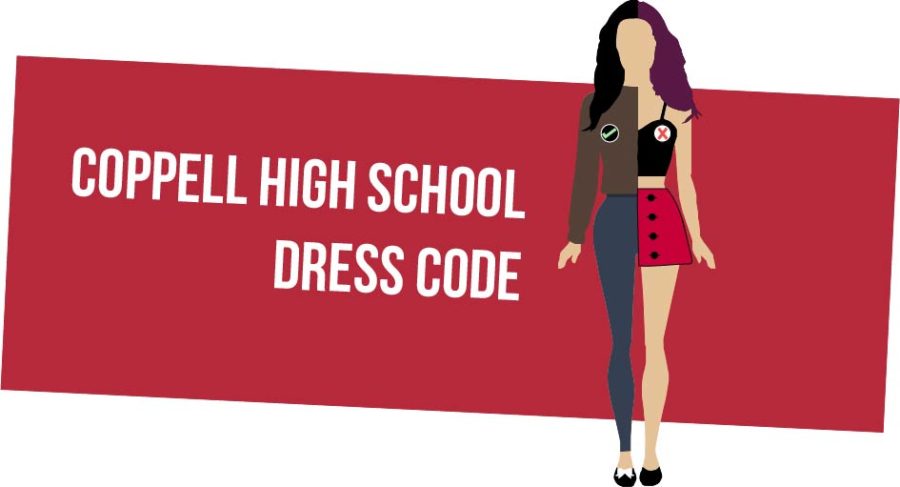The problematic aspects of dress code
Half of this girl is dressed according to the Coppell High School dress code, while the other half is dressed against it. The dress code at CHS restricts revealing clothing such as crop tops and short skirts (right), and approves modest clothing such as full sleeves and long pants (left).
December 4, 2017
Want to rock blue hair or show off the cute new crop top your friend bought you? Unfortunately, the dress code at Coppell High School prohibits both of these things and more.
At CHS, numerous fashion styles students enjoy expressing themselves through are restricted. These include, but are not limited to, vibrantly colored hair, short skirts and spaghetti straps.
Many students feel more comfortable and confident when wearing clothing that happens to fall outside the boundaries of the dress code or when sporting hair that is dyed a color of the rainbow. However, they are scolded for doing what boosts their self-love because the Coppell ISD administration thinks it is at the expense of others’ focus on schoolwork.
“[When students] dress in a way that is provocative and revealing … [they have] become a distraction,” CHS associate principal Sean Bagley said. “We want to create an environment where everyone can be comfortable and focus on learning.”
Despite the administration’s claims, research shows that establishing a dress code does not increase students’ learning. Additionally, most students find the idea of being distracted by their peers’ short clothing or thin straps ridiculous.
“No one’s going to be distracted by my shoulders,” CHS junior Arohi Srivastav said.
If certain students do prove to be distracted by what students around them are wearing, they should be taught not to be. Schools should be teaching teenagers that it is not OK to objectify others into something to be distracted by, instead of teaching the other students not to wear potentially distracting outfits.
Teenagers often struggle with self confidence issues, especially regarding physical appearance. When prohibited from dressing themselves in ways that could help this problem, their struggle only grows. Everyone is the owner of their own body, and because that is where the clothes are going, they should have complete control over what they choose to wear.
“I just feel better about myself when I can wear what I want to wear,” Srivastav said.
Even though the clothes that tend to make me feel comfortable usually do not cross the borders of dress code, I still find the idea of dress code offensive. It is taking away my right to choose what I put on my body.
Dress code also encourages students making negative assumptions are made about an individual based on how they dress themselves. When students see the school staff punishing their peers for their choice of clothing, it strengthens an idea in their head that it is OK to judge people based on how they dress.
“Do not have your midriff showing, do not have your shorts too short,” Bagley said. “We do not want you to have become something that people are talking about.”
Why is the administration telling students to change the way they dress to avoid being talked negatively about, instead of telling other students to stop shaming peers based on how they dress?
Those who support dress code sometimes argue these policies reduce bullying. However, following the same logic as above, if this is a problem then the bullies should be told to stop harassing students for the clothes they wear, instead of the victims being told to change.
Supporters of high school dress code also often claim that the dress code increases professionalism and sets the correct atmosphere for school.
“[Students] are not going out to the beach,” Bagley said. “[School] is a place where you should dress appropriately… as you would in a job scenario.”
However, most of the clothes restricted by the CHS dress code are not clothes people wear to the beach, they are clothes they wear regularly. For example, students wear spaghetti-strapped or off-the-shoulder dresses to many places, such as school banquets, that have the same or higher level of formality as school.
I am not going to argue that dress code is also anti-feminist, even though I am a passionate feminist, because the truth is boys should be allowed to wear crop tops and short skirts as well, if they wish. This isn’t an issue of sexism, it’s an issue of objectifying humans across the board, regardless of their gender.
The dress code should be altered to be more laid back, requiring only that certain body parts are covered. This way, students would not be allowed to come to school naked, but would also have more freedom to wear what makes them comfortable and confident.
Follow Pramika on Twitter @pramika_kadari












ℝ ℂ • Nov 15, 2020 at 5:17 pm
So I think that crop tops should be allowed short shorts should not nor bra tops but I do think that it should be ok to wear a crop top